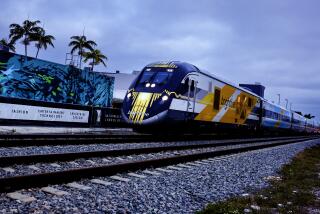Japanâs Magnetic Train May Not Float
TOKYO â It looks like a jet without wings, and whizzes over its test track in the countryside in virtual silence.
Japanâs maglev train--so named because it levitates a few inches above its track on a magnetic cushion--is a tribute to technology.
But after 36 years and billions of dollars of development, this sleek, futuristic showcase of Japanese expertise has yet to carry a single paying passenger.
And critics say it probably never will.
âI doubt it will ever happen. Thereâs no rationale for it,â said Laurant Delgrande, transportation analyst at the investment firm Dresdner Kleinwort Benson, Asia Ltd.
Most other countries already have given up.
The United States stopped development 20 years ago. France is sticking with its conventional high-speed train, the TGV, which achieved a speed of 319 mph in 1990.
Germany is the only other nation still developing a maglev train--for a 180-mile connection between Hamburg and Berlin, its two biggest cities.
The German government formally set up a management company for the project May 5, and officials said construction is planned to start next year. But the project faces strong opposition from environmentalists and other critics who question its $5.5 billion cost.
Transportation in crowded, mountainous and fuel-poor Japan always has been a serious problem.
For designers here, the mass-transit maglev concept is particularly attractive because it offers a way to shed the wheel without the danger of taking to the skies.
Engineers want to use it in the busy corridor between Tokyo and Osaka, Japanâs two largest cities. At least 360,000 passengers travel that route each day.
But maglevâs costs are immense.
An 11.4-mile test track was recently built outside Tokyo for $1.2 billion. That comes out to $101 million a mile. At that rate, it would cost $49 billion to get the rest of the way to Osaka.
*
Central Japan Railway Co. and the government also are splitting an additional $1.3 billion for a 10-year development program taking the project through 1999.
Those costs donât include the billions spent to develop the train over the first 28 years of the project.
Haruo Goto, chief engineer for maglev development at Central Japan Railway, argues that costs are high now because they include expensive computers and sensors needed to gather test data.
The track and train cars will be considerably cheaper once they are mass-produced, he said.
For the maglev to float and reach its highest speeds, it must carry superconducting magnets and keep them cooled to nearly 460 degrees below zero.
To travel safely at 310 mph, the maglev guideway must be flawlessly straight and flat. Smoothing out the curves and bumps in the mountainous region between Tokyo and Osaka would be extremely costly.
Tunnels are especially expensive because they must be drilled large and with flared ends, like a trumpet, to dissipate shock waves produced by a train traveling at such high speeds. Without the flare, engineers worry the waves could shatter windows of nearby homes.
Critics say all this technology is wonderful--but is also an example of what happens when developers become enamored of a new idea without consideration of costs.
âRail technology has advanced to the stage at which it can do most of what maglev was intended to do,â said Tony R. Eastham, an engineering professor at Hong Kong University of Science and Technology.
âItâs not quite as fast, but itâs more affordable, and itâs a proven technology,â he said.
*
Japanâs âshinkansen,â or bullet trains, run on old-fashioned wheels and rails, are reliable and already very fast. The newest models operate at speeds up to 186 mph.
The fastest bullet train makes the Osaka-Tokyo trip in 2 1/2 hours. A maglev train could cut an hour off the trip, but analysts doubt the time savings would justify the cost of an entirely new system.
âThis kind of thing is going to be very, very expensive to build,â said Richard Whitehurst, a transportation analyst at the Tokyo office of the SBC Warburg investment firm. âSure theyâre super fast, but youâd have to charge people an awful lot of money to make it pay.â
Exactly how much a maglev ticket would cost isnât clear.
Central Japan Railway wonât say what the system would cost to run. But executives admit it wonât be cheap.
âEvery part of the project is new and expensive,â conceded Satoru Sone, an engineering professor at the University of Tokyo who is advising the railroad on the project.
Estimates of the costs of linking Tokyo and Osaka with a maglev line range from $23 billion to $77 billion, Sone said.
But even the best approximations are a stab in the dark, he added.
âFrankly, I donât think anybody knows how much it will all cost.â
More to Read
Sign up for Essential California
The most important California stories and recommendations in your inbox every morning.
You may occasionally receive promotional content from the Los Angeles Times.










